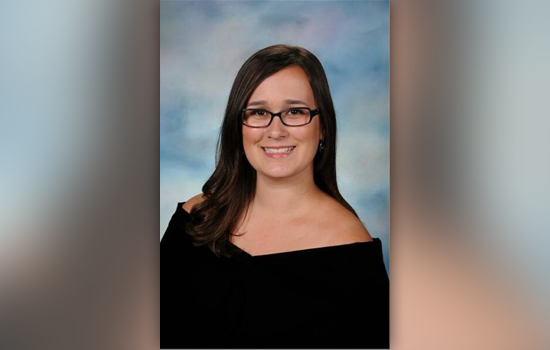First-year chemistry student to present research
Student Spotlight Nicole Pannullo, first-year chemistry
Nicole Pannullo, a first-year chemistry student, will display a poster of her research on intermolecular energy transfer during the American Chemical Society’s national conference.
Nicole Pannullo, a first-year chemistry student, plans to showcase her ongoing research on intermolecular energy transfer at the American Chemical Society’s national conference in San Diego March 13-17. Pannullo, from Patchogue, N.Y., will present her findings of energy transfer in natural organic matter from the Suwannee River during the student poster session. She received the Undergraduate Research Award from the Rochester section of the American Chemical Society to help fund her travel expenses for the conference. She also plays clarinet in the Pep Band and is a member of the Equestrian Club.
Question: What brought you to RIT?
Answer: To be honest, I almost didn’t apply until my dad talked me into it. When I came here, I just loved it. I like the community and the chemistry program RIT offers. Everyone I talked to seemed very personable. I’m hard of hearing so that was also something I considered when I decided to come to RIT.
Q: Why did you choose to major in chemistry?
A: I really like that the field of chemistry is so broad. You can do so many things with it such as exploring medicine or environmental issues. It’s cool seeing the different reactions between substances and being able to create something new. I also like working in a lab and being able to see everything in action. That’s why I’m interested in research.
Q: What made you decide to conduct research on intermolecular energy transfer?
A: When I was in high school, Todd Pagano, director of NTID’s Laboratory Science Technology program and professor, contacted me and talked about research and how important it was for him to get students involved. I really liked his passion for research so I thought it would be good to work in a lab with him. He gave me a couple options for projects and I chose the intermolecular energy transfer project. Honestly, I wasn’t really sure what kind of research I wanted to do in chemistry. I just wanted to explore because I didn’t have any experience in research. I found it really interesting working on such a small scale looking at the interaction between individual molecules.
Q: How did you conduct the research?
A: It was a pretty straightforward process. Morgan Bida, analytic instrumentation specialist and lab assistant, and I made solutions of natural organic matter from the Suwannee River with increasing concentrations of tannic acid and we ran the absorbance spectra for the solutions. After that, we used a spectrofluorometer to make excitation emission matrix spectra (EEM) of each of the solutions, which measure the fluorescence. Based off of the EEM findings, we created a model in a program called PARAFAC, which mathematically separates the fluorescence of the components of the solutions without having to physically separate the chemicals. PARAFAC has assumptions that need to be satisfied in order to use it. We were testing PARAFAC’s assumption that no energy transfer occurs between molecules and we found a situation where we believe energy transfer is occurring and the PARAFAC assumption is violated. As a result, we essentially “broke” PARAFAC and it is giving us a model that doesn’t make sense.
Q: What are your findings?
A: We haven’t actually proved there is energy transfer yet. We believe there is energy transfer but there are still a few more tests we want to do in the lab before we make that claim. What happens when you have energy transfer is you have two molecules that become excited at overlapping wavelengths, a molecule that donates energy and a molecule that accepts energy. When you look at an EEM, the fluorescence in the molecule that donates energy weakens to the point where it doesn’t show up at all in the case of our experiment. In the accepting molecule the fluorescence increases and changes shape. That’s the evidence of energy transfer we have found in our molecules. We added tannic acid, the donor molecule, in increasing concentrations and we saw the acid isn’t showing up on the EEM. The natural organic matter’s fluorescence was increasing and changing shape. A lot of scientists use fluorescence and PARAFAC to study natural organic matter like ours and if what we are seeing is energy transfer, then these other scientists need to be aware of what it looks like and they need to be careful not to use PARAFAC if their solutions are capable of energy transfer.
Q: How have Pagano and Bida helped you conduct your research?
A: The research project is something that Dr. Pagano started and that he wanted me to look into further. He goes over the lab results with me and advises me what to do next. Morgan has been working in the lab with me and helps me develop the technical skills I need to conduct research. They both have been really welcoming and patient explaining the project to me. It’s also exciting to hear about their experiences conducting research.
Q: How were you selected to receive the Undergraduate Research Award from the Rochester section of the American Chemical Society?
A: Last semester, Dr. Pagano encouraged me to register to present my research at the American Chemical Society’s national conference in San Diego. Over the intersession, he also nominated me for the award to help fund my travel expenses to attend the conference. He didn’t tell me he nominated me until I had won the award.
Q: What does receiving the award mean to you?
A: I was pretty shocked. It makes me really happy to know I’m doing something right and I’m glad I’m representing RIT well by winning the award.
Q: What do you hope to learn at the national conference?
A: It’s going to be a good networking experience and give me the opportunity to see what other students are doing in different areas of research. I’m looking forward to seeing San Diego, too.
Q: What is the next step in conducting your research?
A: I will continue trying to prove there is energy transfer by adding tannic acid at lower concentrations and adding it in smaller increments. I’m going to do it on a really small scale because there is something called the inner-filter effect correction that could be affecting the EEM results I’m looking at. However, the inner-filter effect correction only creates an issue for the solutions with higher concentrations of tannic acid where the absorbance is high so I’m going to look at really low concentrations to see if we get the same trends that point toward energy transfer.
Q: What are some of your favorite memories at RIT so far?
A: Doing research has definitely been one of my top experiences here. Playing in the Pep Band and going to hockey games has been a lot of fun too. I definitely feel like I have a great group of friends here.
Traci Turner compiles “Student Spotlight” for University News. Contact her at trt6538@rit.edu with suggestions.






